
Does time have a beginning, middle, and an end, or does it continue like the infinite, repetitive motion of the sea, though we are born to die? And who really controls time and life? Is it the highest of all powers, the dual faced Janus of Roman mythology, or the common individual who sleeps, dreams, and goes about the most mundane of business?
These are the questions that philosophers have grappled with from what seems like the very beginning of life as we know it, and then some; they are also the subject of Casey T. Malone’s Blood of the Witch Trilogy, and more specifically, the final installment of his fascinating cinematic triptych, aptly named, Coda Nera.
In Coda Nera, Malone and his silent-film-version of FBI-hunters (led by the masked Magician, and supported by Tom and Sam Janus, the Pumpkin Vendor, and the ordinary, dreaming man named Peter, who appears to have instigated all the horror), seek the final disposition and adjudication of Malone’s primary suspect, Abby Thelma, aka the Witch in the long striped stockings.
Unfortunately, the Witch has devolved into the most toxic personification of evil imaginable, and is not only devoid of her striped stockings, but all semblance of what was once her humanity.
Coda Nera plays out like the mechanism of a finely tuned clock, whose life force is not the usual tick-tock, but music. Once again, the magnificent score of The Warshack Jazz leads us through the make believe forest, down the ancient block plans, to places best left undisturbed.
In the end, those who are dead return to life, and all seems right with the world… except for one nagging little trick that leaves all questions unresolved, and all characters and Film Threat movie-viewers right back where they started…
As far as I’m concerned, there are not enough stars to rate Coda Nera, or the entire Blood of the Witch Trilogy. Casey T. Malone’s work defies any aspect of cinematic critique, or clear-cut philosophical explanation, and can only be described as, awesome.
This film was submitted for review through our Submission for Review system. If you have a film you’d like us to see, and we aren’t already looking into it on our own, you too can utilize this service.
